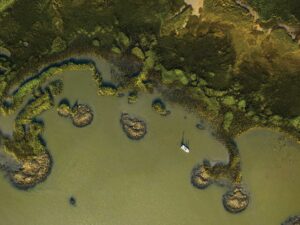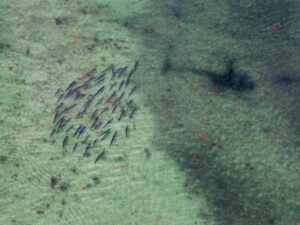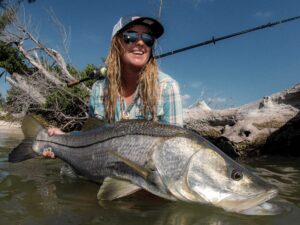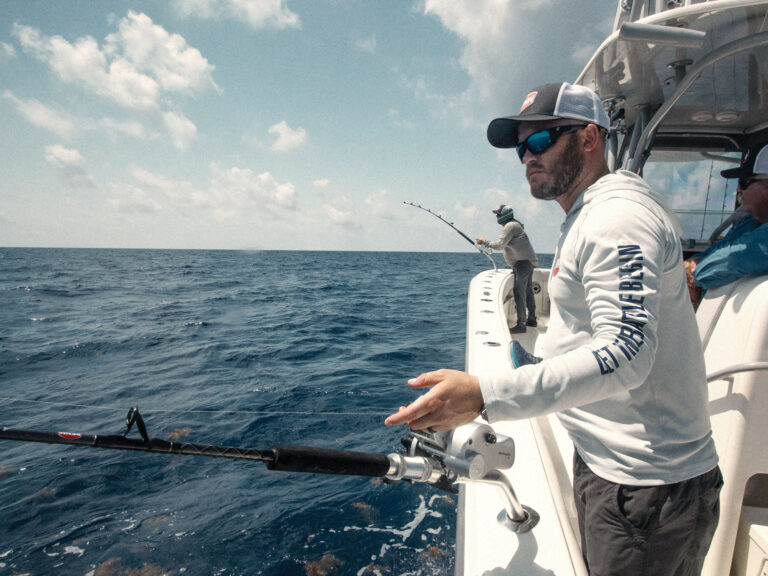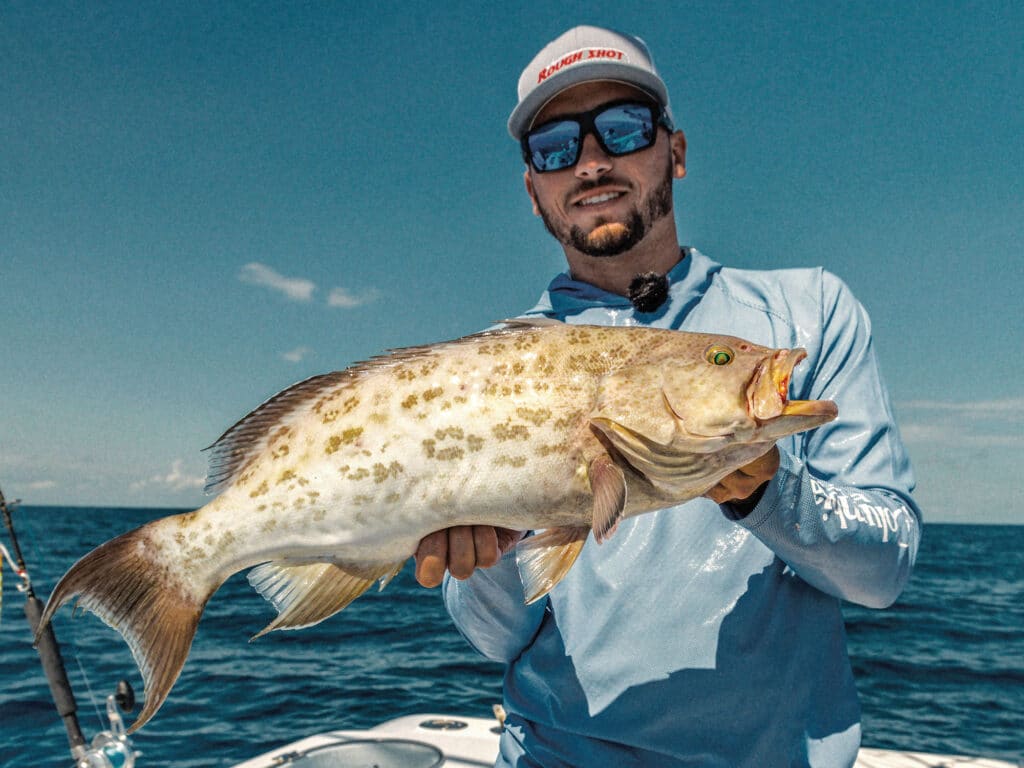
Capt. DJ Barrios was thinking ahead that morning. We were on a yellowtail spot not far from the anchorage at Fort Jefferson, where we had just spent the night. I was free-lining slivers of bonito and pulling in snapper as fast as I could. But Barrios had something bigger in mind.
As I landed yellowtails, he lowered a live pinfish to the bottom on a 20-pound-class spinner and quickly found himself in a give-and-take struggle I wasn’t sure he’d win. He prevailed and up came a firetruck red grouper—one of the largest I’ve ever seen. Obviously, I wasn’t the only one who was stalking the yellowtail school.
The Shrinking Final Frontier
The Dry Tortugas, some 70 miles west of Key West, has long been dubbed the final frontier of Florida Keys fishing. Reaching Dry Tortugas National Park by private boat can be an arduous undertaking. Brisk winds and conflicting currents along some stretches can spawn tumultuous seas, such as the gap between Boca Grande and the Marquesas, the Quicksands and Rebecca Shoal. A boat’s seaworthiness, power, reliability and fuel capacity factor prominently in any decision to embark on such a journey. The reward? Superb bottomfishing with little pressure.
With today’s larger center-consoles, the Dry Tortugas is now a day run for many anglers and Key West guides. With light winds, one can depart Key West at sunrise, fish most of the day, and return around 5 p.m. We’ve done this with my boat. High speeds make short work of the long run; the Dry Tortugas is now readily accessible. That “final frontier” moniker doesn’t work anymore, but it’s still an amazing place to fish.
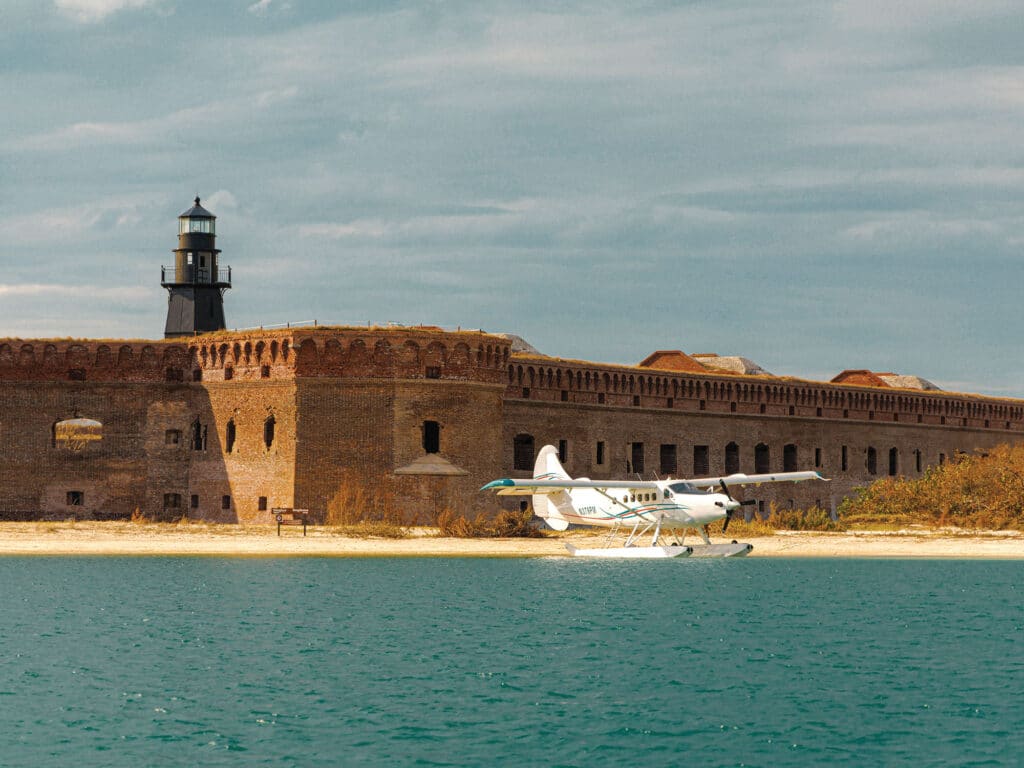
Fun at the Fort
Fort Jefferson is the largest brick masonry structure in the Americas. It’s composed of more than 16 million bricks and was built in 1847 to protect the strategic deepwater anchorage in this region (the very same one we overnighted in). Later it served as a prison. Today it’s a major tourist mecca accessible by seaplane, tour boats and even recreational boaters.
On this trip, we opted to spend the night at Fort Jefferson. It would be my first all-nighter here, but I’m not a rookie at sleeping on boats. Credit this to the times I spent as a kid fishing with my dad off the Marquesas, some 28 miles west of Key West. Limited fuel capacities and low-horsepower engines resulted in many overnighters there. Back then, the Marquesas were considered the final frontier, and the Dry Tortugas, some 50 miles beyond the Marquesas, may as well have been in outer space.
My first Tortugas overnighter was ushered in with happy hour appetizers and Papa’s Pilar rum for Barrios, myself and three TV production team members. We dined on freshly caught fish, swapped fish tales, and unfurled sleeping bags and beanbags to get a restful evening under the stars. OK, so maybe it wasn’t as luxurious as it sounds. More on this later.
Bottomfishing Par Excellence
With live pinfish, fresh ballyhoo, sardines, squid, bonito and three 25-pound blocks of chum, we departed Key West shortly after sunrise. Averaging around 50 mph, we anchored at our first spot some 90 minutes later, dropping on a mix of sea fans and scattered corals in 70 feet of water.
The chum hoop was deployed and two live pinfish lowered to the bottom. I immediately hooked up with a fish hellbent on lodging in structure. I opened my bail, hoping it would swim out. Then Barrios hooked a fish, which charged away from the boat instead of straight down. As anticipated, a beautiful mutton snapper came over the gunwales.
I continued waiting out my fish. After all, it was down here with Daniel Delph where I hooked a big grouper on a 20-pound spin outfit more suited for yellowtailing. That fish rocked me up four different times. I spent close to an hour free-spooling and coming tight on the grouper to no avail. Finally, the wait paid off, and I bested a 55-pound black grouper on the fifth attempt. Unfortunately, I had no luck with this fish and had to break the line.
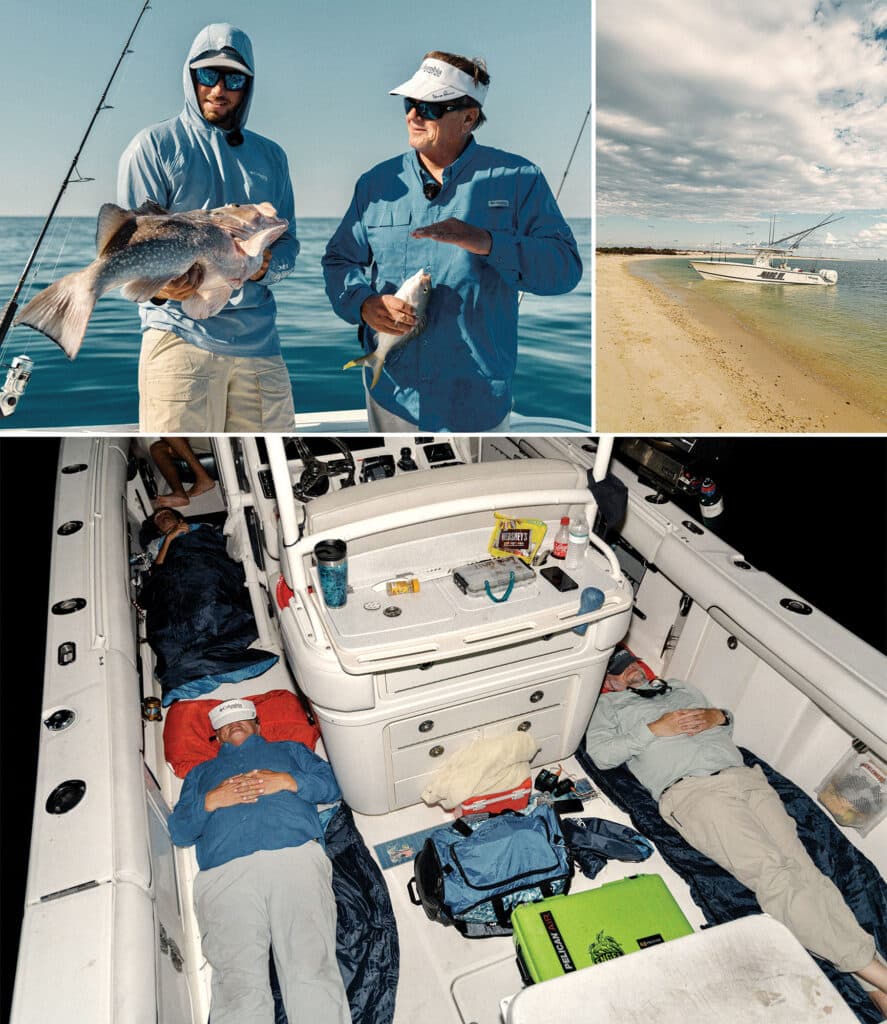
Stick and Move
We combined anchoring and drifting over prominent bottom structures. We’d anchor on scattered pieces of hard bottom in 50 to 80 feet and drift over deeper ones, which included ledges in 180, 220 and 250 feet. In both instances, we deployed a chum hoop to stir up surface activity.
“Anything that looks like it could hold bait could hold fish,” Barrios says. “It could be as small as a couple of sea fans or as large as 10 big coral heads. If you’re marking bait on the sonar, the fish will be there.”
We scored monster red grouper, big scamps, and a mix of black, strawberry and gag grouper. Plus, there were the yellowtails, muttons, and oddities such as squirrelfish, oversize triggerfish, bonito, ’cudas and sharks. We were here in early October.
Light-Tackle Paradise
In the domain of big bottomfish and occasional pelagics, go light and have some fun. You might lose a battle but, in the long run, you’ll gain more hookups and land some amazing catches.
Our bottom tackle included 5000-class Penn Battle III and Penn Authority spinners. For conventionals, we used Penn 15 LD Torque reels. Our rods were rated for 40- to 80-pound lines. We spooled with 30-pound Sufix 832 braid topped with 50-pound Sufix fluorocarbon leaders. Hooks were VMC 3X-strong, size 4/0 inline circle hooks.
For yellowtails, we dropped down to 4000-size spinners paired with 12-pound monofilament. Silversides, bonito slivers and small strips of ballyhoo sweetened our No. 1 inline circle hooks and 1/16-ounce yellowtail jigs.
Seasons
Fishing is productive off the Tortugas year-round. However, the cooler waters from October through May are prime for big grouper and muttons. “The cooler waters bring grouper and snapper in shallow, even on the patch reefs,” Barrios says. “The mutton snapper spawn around the end of May can be incredible. As far as yellowtails, good fishing can be had all year.”
Read Next: Backcountry Boat Camping and Fishing in the Everglades
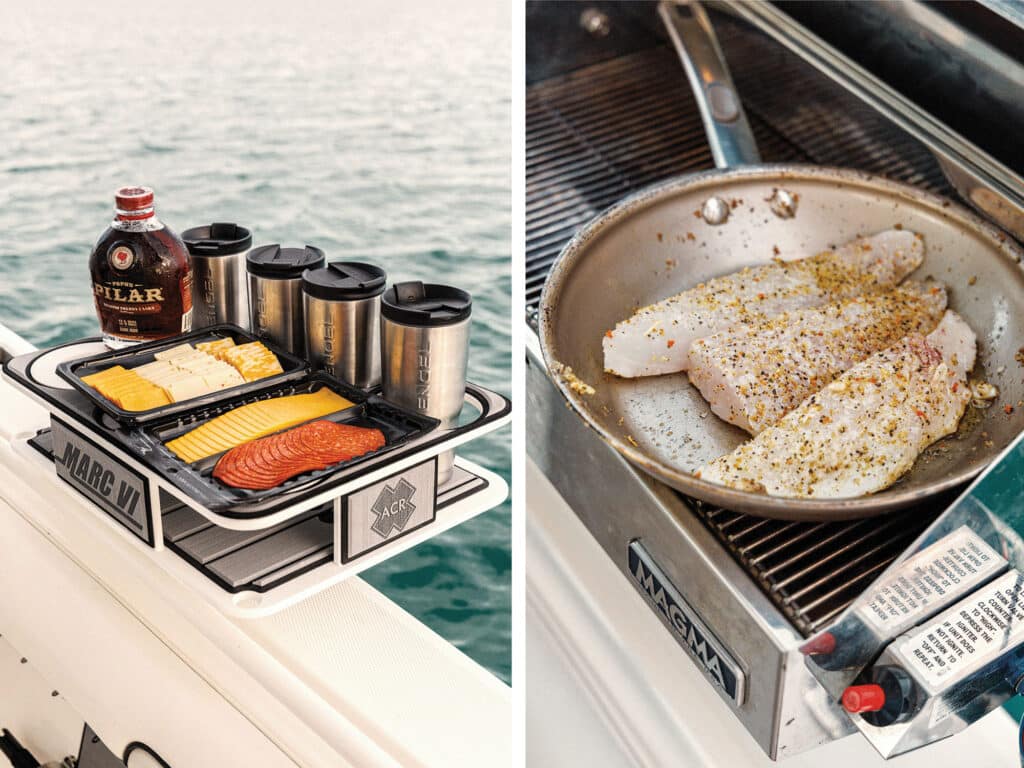
Back to the Party
After a solid day of fishing, I steered Marc VI into the anchorage at Fort Jefferson. Before anchoring for the evening, we beached the boat and took a tour of the historic facility. Just the change in water color around the fort, ranging from deep blue to green to turquoise to clear, was well worth the venture.
At anchor, Barrios cleaned a scamp and some yellowtails while I readied the grill. Initially, it appeared we’d be the only boat present. But shortly after our happy hour, lobster boats entered the anchorage and dropped their hooks for the evening. Rob “the Swede” Greene prepared and grilled the fish. There are no better fish dinners than the ones prepared from those that were swimming around hours earlier.
For luxuriously sleeping five individuals, I’ll admit my 33-foot Mako center-console can’t compete with a Marriott resort. However, we each took our respective sleeping bags, claimed a spot on deck, and called it an evening under an incredibly beautiful star-filled sky.
The morning alarm was the sound of diesels firing up and lobster boats leaving for work. Greene grilled sandwiches for breakfast. Soon after, we were yellowtailing for an hour or two before heading back to Murray Marine on Stock Island.
“People are drawn out here to see a national park in the middle of an ocean,” Barrios says. “It’s a huge tourist attraction accessible by ferry, seaplane, and charter and recreational vessels. It’s the whole experience they’re after. Plus, it’s pretty cool when you roll up on it and see this huge brick structure rising from the ocean.”
Planning a Trip
Capt. DJ Barrios is a fourth-generation Key West guide. He operates a 27-foot center-console and does it all around Key West. He’s also available to guide aboard customers’ boats. Contact him at roughshotchartersllc.com.
Where to stay in Key West: There are countless accommodations in Key West. The Capitana Key West (thecapitanakeywest.com) is a new boutique waterfront hotel that deserves a mention. It’s strategically located between Stock Island and downtown Key West. If you have the time during the day, consider a visit to Papa’s Pilar Rum Distillery.
Where to eat: Hogfish Bar & Grill on Stock Island (hogfishbar.com); Roostica Wood-Fire Pizzeria & Italian Restaurant (roostica.com)
Boating permit for the Dry Tortugas: A permit is required for all private boaters fishing in park waters. Obtain the free boat permit at the park’s headquarters on Garden Key. This must be done before fishing. ”It’s a self-service kiosk that helps collect park usage data,” says Andy Newman, Florida Keys’ media relations director. “No boat permit is required for vessels simply transiting the park.”


